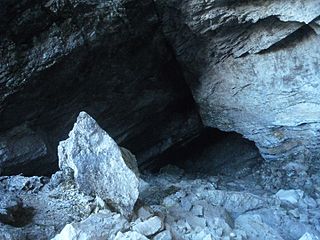Schneckenlochhöhle
| Schneckenlochhöhle
|
||
|---|---|---|
|
Schneckenlochhöhle entrance |
||
| Location: | Gottesacker area Vorarlberg | |
| Height : | 1270 m above sea level A. | |
|
Geographic location: |
47 ° 22 '28 " N , 10 ° 4' 5" E | |
|
|
||
| Cadastral number: | 1126/1 | |
| Geology: | Schrattenkalk | |
| Type: | Rock boundary cave | |
| Overall length: | 3558 m | |
| Level difference: | 148 m | |
The Schneckenloch Cave , also known as Schneckenloch , is a large karst cave near Schönenbach in the Austrian state of Vorarlberg .
location
It is located on the northern slope of the Sevischrofen ( 1659 m ), on the western edge of the Gottesacker area , in which there are a large number of caves, and is probably the most famous cave in Vorarlberg. The entrance of the cave is at an altitude of 1270 m , it is located in the area of the municipality of Egg in the Bregenz Forest . The name of Sevischrofen is derived from the seven shrub found there ( Juniperus sabina , stink juniper).
The location of the cave entrance is on the official topographic maps of Austria (ÖK 50-BMN sheet 112 Bezau, ÖK 25V-BMN sheet 112 Bezau; ÖK 50-UTM sheet 2219 Lech, ÖK 25V-UTM sheet 2219-W Lech) and Bavaria ( TK 25 sheet 8626 Hoher Ifen, TK 50 sheet L 8726 Einödsbach im Allgäu, UK 50 L8 Allgäu Alps). The cave portal can be seen from Schönenbach. From here the cave can be reached in about 1½ hours on foot. It takes 2½ to 3 hours to navigate the main passages of the Schneckenlochhöhle. A tour is only possible with a guide.
Degree of exploration
Although the large cave has long been known and has been explored, unknown side passages are repeatedly discovered and opened up. The Schneckenloch Cave was described for the first time in a newspaper article around 1900, and has been a geological natural monument since 1955.
The total length of the Schneckenloch cave known today is around 3558 m, the greatest difference in altitude 148 m. The rock boundary cave was formed at the base of the Schrattenkalkes , on the border with the water- retaining Drusberg layers . Both rock formations belong to the Helvetica . The large-scale, layer- joint-bound corridor parts run along this rock boundary.
Inspection and condition
The entrance hall behind the huge portal is accessible in daylight, the inner parts of the karst cave only with artificial lighting. The floor of the cave is largely covered with rock fall, partly also earthy, sandy and loamy. Hall-like rooms alternate with narrow and low corridors, in some places there are water inlets. A large main course forks after about 500 m into two aisle sections, an east aisle and a north-east aisle. The large parts of the cave are marked by eruptions.
Previously existing stalactite jewelry has been largely destroyed or looted. At the entrance to the cave there are information boards with an overview drawing. The Schneckenloch Cave is also an important wintering area for bats. The following five species were observed: mouse- eared bats ( Myotis myotis or Myotis blythii ), water bats ( Myotis daubentonii ), long-eared bats ( Plecotus sp.), Pug bats ( Barbastella barbastellus ) and bearded bats ( Myotis mystacinus or Myotis brandtii ). 70% of the bats counted were whiskered bats.
Schneckenlochbach caves I to III
Below the entrance to the Schneckenlochhöhle there are entrances to other protected caves, the Schneckenlochbachhöhlen I to III. These are only a few meters long, cave II around 78 meters.
literature
- Hubert Trimmel : The Schneckenloch (1270 m) near Schönenbach. In: Vorarlberger Landesmuseumsverein (ed.): VLMV yearbook 1955. Bregenz 1956, pp. 87-104
- Walter Krieg: The Schneckenloch - Vorarlberg's largest cave. In: Heimatbuch Egg. Bregenzerwald / Vorarlberg, Ruß, Bregenz 1974, pp. 23-28
- Walter Krieg: The western Ifen area with the Schneckenloch and Löwenhöhle . In: Vorarlberger Landesmuseumsverein (ed.): Karst und Höhlen in Vorarlberg, Bregenz 1988, pp. 29–32
- Richard Fumy et al. a .: The caves of the Gottesacker- Hochifen area. In: Association of German cave and karst researchers (ed.): Karst and cave 2000/2001: Hochifen and Gottesacker, a karst landscape between the Bregenz Forest and the Allgäu Alps . Munich 2000, pp. 89-158, ISSN 0342-2062
Web links and sources
- http://www.lochstein.de/hoehlen/A/vorarlberg/schnecken/schnecken.htm
- Schönenbacher Rundweg and the Schneckenloch Cave
- Snail hole. Vorarlberg cave explorers, accessed on May 31, 2012 (with pictures of the cave).
Individual evidence
- ↑ Vorarlberg cave explorers: Longest and deepest caves in Vorarlberg and the working area , accessed on September 10, 2017.
- ↑ Hans Walser: Bats and Caves: Occurrence - Endangerment - Protection. Vorarlberger Naturschau 15, 115–126, 2004. pdf
- ↑ Walter Krieg, Rudolf Alge: Vorarlberger Naturdenkmale: from giant trees, caves and devil's stones , p. 48.

